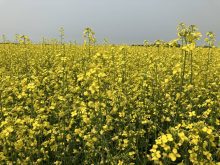“We should be home, getting to work!”
– Scott Day, Mafri
With so many unseeded acres on the Prairies, the problem has even attracted the attention of politicians, who have responded with a promise of cheques in the mail.
But, ultimately, what to do about it is in the hands of the farmers who got rained out.
On the Manitoba Zero Tillage Research Association’s annual tour July 8, University of Manitoba Professor Gary Martens led a brainstorming session on possible options.
Read Also

Manitoba sclerotinia picture mixed for 2025
Variations in weather and crop development in this year’s Manitoba canola fields make blanket sclerotinia outlooks hard to pin down
First, all eyes scanned the ground to identify the weeds poking up through the bare, dry soil, which was beginning to look a bit like concrete under the warm sun. Whitening at the surface indicated salinity in some spots.
Weed species included the usual suspects, such as round-leaf mallow, cleavers, goat’s beard, foxtail barley, redroot pigweed and others. Chemfallow would prevent them from making a deposit in the seed bank.
To encourage those present to think outside the box, Martens told how one of his students once hit the jackpot with a late-season catch-up crop.
In 2005, one of his agriculture diploma students went back to the family dairy farm and bought 320 acres of land. That spring was rained out, and none of it was seeded.
“They got their $50 per acre from crop insurance,” said Martens. “The old man was content with that. But she was a persistent girl. She said, ‘No. We’ve got to do something.’”
The student decided to plant her half-section to buckwheat. By fall, it looked “gorgeous” and yielded 23 bushels per acre at $9/bu., said Martens.
“She got that, plus the $50. She got just over $200 an acre, and her dad had nothing for the rest of the farm. He was quite proud of his daughter.”
So, what to do with the millions of unseeded acres this year, this late in the season?
“Sow buckwheat,” quipped one man, to much laughter.
Kristen Phillips, a crop adviser with Manitoba Agriculture, Food and Rural Initiatives at Virden and an MZTRA board member, said the farm’s managers had already decided to seed a green manure crop of oats and peas.
“We’re going to let it grow up, then use a knife roller to work it in without tilling the land, and then sow winter wheat into it this fall,” said Phillips.
With that strategy, because the rolled crop will be flat and won’t provide stubble to protect the winter wheat, crop insurance will only offer a reseeding payout if it fails.
If it winters well, however, it will be insured the following spring from June 20 onward.
For those with cattle, another option
might be to seed oats for green-feed, one man suggested.
“I’d just sow oats, then in two months, let the cattle out to graze it,” he said.
In Kansas, winter wheat or fall rye are often sowed, then grazed lightly to avoid damage. Here, sowing early before the Aug. 20 crop insurance deadline would allow for growth.
Scott Day, a MAFRI diversification specialist from Melita, noted how unseeded acres in 1999 were hurt by increased salinity.
Any crop to cover bare soils susceptible to evaporation might help to “grow the water out of the ground” instead, Martens added.
“Getting something on here rather (than using chemfallow) would probably have a really important benefit” as far as salinity issues are concerned, said Day, adding that barley is best where salt is a problem.
“Even if it’s the first of July, maybe even barley or oats and hope for the best. If it freezes, then cut it. We would have got grain last year.”
Picking the shortest-season crop might pay off, but extreme short-season varieties are virtually nonexistent at present.
“My dad tells me that we used to have 60-day oats. One of the things that we’ve done with our plant breeding is increase maturity to fill the season completely so that we can increase our yields. The more days the factory is open, the more you get,” said Martens.
“But that means we don’t have anything for a salvage year like this.”
A warm fall such as last year’s would help stretch the window, of course. One seed dealer present suggested 84-day maturity Polish canola, but added that seed might be hard to source this late in the game.
Time is ticking, even on the shortest-season varieties in the Seed Manitoba guide. For example, the quickest barley variety in the guide is an 86-day barley.
“Regular Argentine canola, wheat – you name it – it’s typically 100 days,” said Martens.
With the Aug. 20 winter wheat crop insurance deadline in mind, planting a mix of fababeans and winter wheat would stand up and create a stubble crop. The beans would fix a bit of nitrogen, then die off with the frost.
Some organic growers use peas, or whatever is cheap, to do the same thing, one man noted. Cleaning bin-run seed might be an option, if supplies are not available.
Oilseed radish, turnips, or establishing hairy vetch could offer alternatives that might provide seed for future polycrop cocktails, MZTRA farm manager Lindsay Coulthard added.
“We should be home, getting to work!” joked Day. [email protected]


















